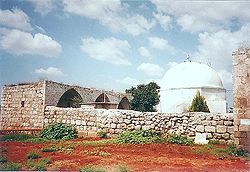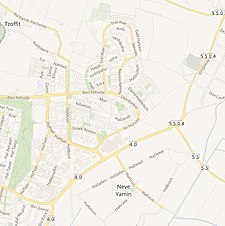Kafr Saba
كفر سابا | |
|---|---|
 Mausoleum of Nabi Yamin, with riwaq (prayer hall) to the left. | |
| Etymology: the village of Sâba (from Aramaic )[1] | |
A series of historical maps of the area around Kafr Saba (click the buttons) | |
Location within Mandatory Palestine | |
| Coordinates: 32°10′52″N 34°56′14″E / 32.18111°N 34.93722°E | |
| Palestine grid | 144/176 |
| Geopolitical entity | Mandatory Palestine |
| Subdistrict | Tulkarm |
| Date of depopulation | 15 May 1948[4] |
| Area | |
| • Total | 9,688 dunams (9.688 km2 or 3.741 sq mi) |
| Population (1945) | |
| • Total | 1,270[2][3] |
| Cause(s) of depopulation | Military assault by Yishuv forces |
| Current Localities | Hak'ramim,[5] Beit Berl, Kfar Saba, Neve Yamin |
Kafr Saba (Arabic: كفر سابا) was a Muslim village famous for its shrine dating to the Mamluk period and for a history stretching back for two millennia.[6][7] In Roman times, it was called Capharsaba and was an important town in Palestine.[8] By around 1000, it was noted as a village with a mosque.[9] The people of Kafr Saba were said to have come from Hebron because of crop failures.[10]
The village was depopulated of its Arab residents by Jewish forces on May 13, 1948, one day before the new State of Israel was declared.[11][12]
Much of the village's ruins were built over as the neighboring Israeli town of Kfar Saba expanded in the late 20th century; the location of the built-up area of the village is now the Shikun Kaplan area of Kfar Saba, and part of it is known as the "Kfar Saba Archaeological Garden" or "Tel Kfar Saba".
Two domed maqams remain, located on either side of Route 55 between Kfar Saba and Qalqilya. The larger of the two is called the Tomb of Benjamin and is situated on the east side. About 40 meters (44 yd) away, on the west side of the road, is a much smaller shrine named Nabi Serakha.[13] The Tomb of Benjamin shrine sits on what has historically been considered by Jews to be the biblical character Benjamin[14] and was later taken over by the Breslov sect of Haredi Judaism.
- ^ Palmer, 1881, p. 174
- ^ Government of Palestine, Department of Statistics, 1945, p. 21
- ^ a b Government of Palestine, Department of Statistics. Village Statistics, April, 1945. Quoted in Hadawi, 1970, p. 75
- ^ Morris, 2004, p. xviii, village #193, Also gives the cause for depopulation
- ^ Morris, 2004, p. xxii: settlement #106, 1949.
- ^ Masalha 2007, p. 69
- ^ Waked, Ali (2005-05-15), "Palestinians mark 'catastrophe'", Ynetnews, ynet, retrieved 2009-08-13
- ^ Cite error: The named reference
arielwas invoked but never defined (see the help page). - ^ Cite error: The named reference
Khalidi, 1992, p.555was invoked but never defined (see the help page). - ^ Grossman, D. "The expansion of the settlement frontier of Hebron's western and southern fringes". Geography Research Forum, 5, 1982, p. 64.
- ^ Benvenisti, 2002, p. 273
- ^ Cite error: The named reference
Morris246was invoked but never defined (see the help page). - ^ Petersen, 2001, pp. 233, 235
- ^ Egypt and Syria in the Fatimid, Ayyubid, and Mamluk eras : proceedings of the 1st, 2nd, and 3rd international colloquium organized at the Katholieke Universiteit Leuven in May 1992, 1993, and 1994. D. De Smet, Urbain Vermeulen, K. d' Hulster, J. van Steenbergen, G. Schallenbergh, Katholieke Universiteit te Leuven. Leuven: Uitgeverij Peeters. 1995. p. 424. ISBN 90-429-0671-5. OCLC 39157124.
{{cite book}}: CS1 maint: others (link)
© MMXXIII Rich X Search. We shall prevail. All rights reserved. Rich X Search





